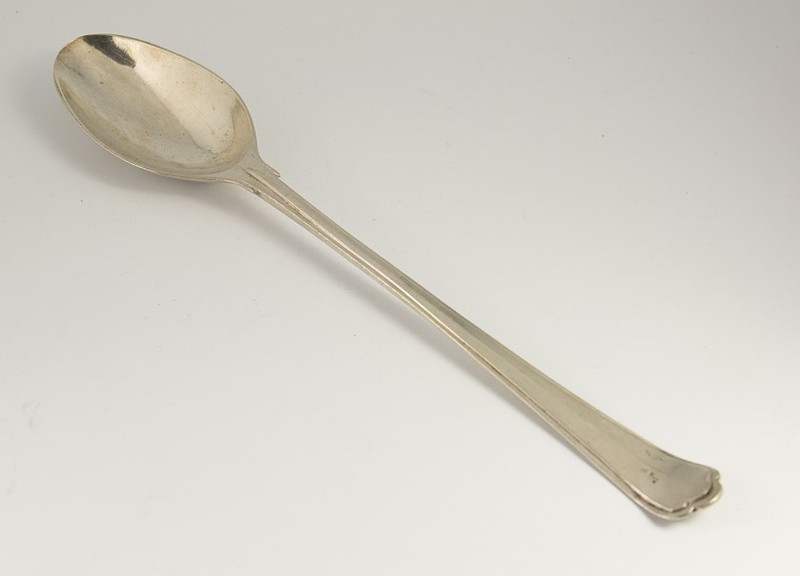
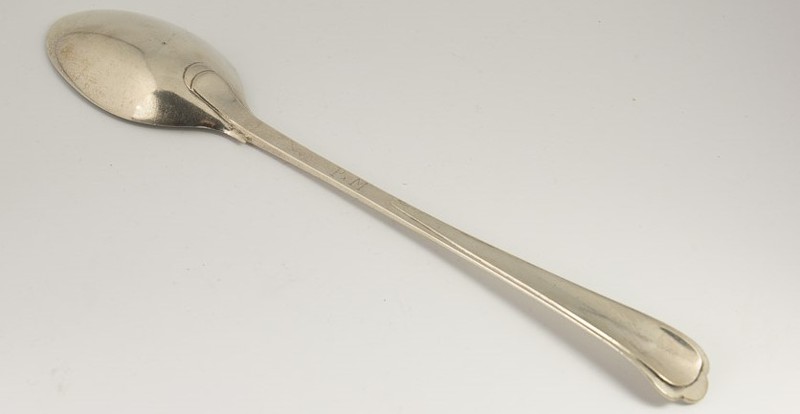
A few days ago I received a request for information about the marks on this silver spoon. The dog-nose spoon with double drop to the heel of the bowl, has one particular mark of a key in contour at the back of the stem, and two vague marks at the front near the tip of handle. At the back of the spoon we also see the engraved initials P^M.
The mark on the back of the stem;

Marks on tip of spoon;

Close up:
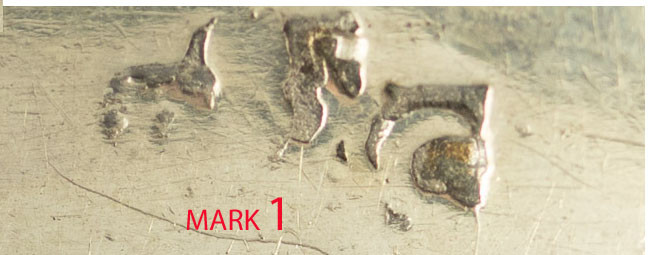
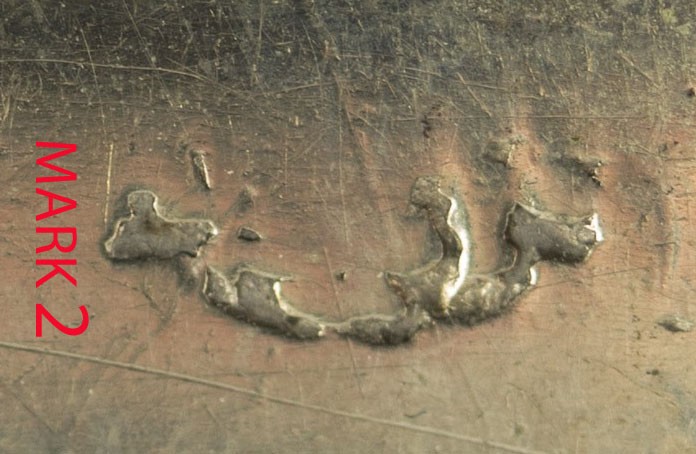
It must be said that apart from the key mark, the two marks at the tip are neither clear nor convincing. A single key mark could refer to the Dutch city of Leiden, cities in Germany, and a key was used by the Belgian city of Leuven. Taken into consideration the location of the (hall)marks, at the front of spoon’s tip, the style of the spoon and marks, Leiden drops of the list. Germany comes in mind and I asked our German expert Theo for his opinion. Nein not German. Although I was convinced the key does not point to Belgium, I contacted the Diva museum in Antwerp. To my surprise I received the following reply of the Diva’s head Collection and Research;
Earlier this year I was asked about a similar fork with the same owner initials P^M. In addition to the key and the maker's mark AC with flowers (?) in between, there was also an octagonal standard mark for silver that was used in the Kingdom of Lombardy-Venetia from December 25, 1810: a globe including the number 2 and 7 stars around it. This gave a date ante quem for this fork. As far as the key mark is concerned, I can draw the same conclusion for the serving spoon: “The key does not point at all to Leuven”. The maker's mark on the fork and spoon are, in my opinion, identical.
Hurray, I thought piece of cake, we got it. I contacted our Italian expert Andrea for advice. Andrea replied; The photographed spoon has the typical eighteenth-century Venetian shape, which however was also produced later and also in other cities. The marks are very worn and I have to study them a bit longer before I can tell if I recognize anything or not. Actually this spoon is a little strange, it's the first time I've seen a cutlery made in Venice with hallmarks on the front. They are usually on the back and, in eighteenth-century cutlery from Venice, they are often struck both on the handle and on the bowl. Regarding the fork, Andrea asked me are you sure there are no other, more marks on the fork? I could not answer her question and thought the best was to get some images of the fork and marks. Again it proves a picture is worth a thousand words and we went from Venice to Verona.
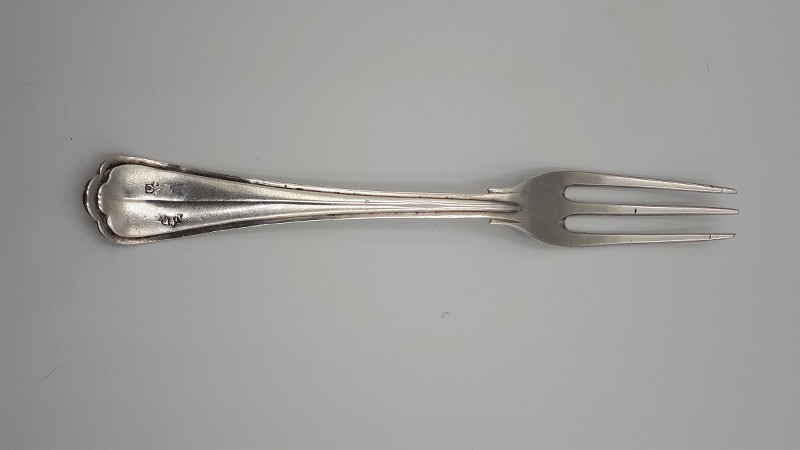

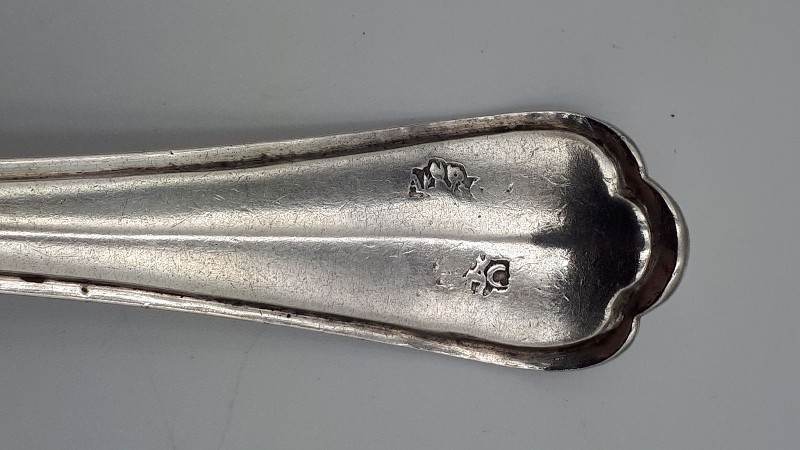

From left to right; 1. dog's head with collar the assay office mark for the city of Verona (#85), 2. Heptagonal standard mark, used Kingdom of Lombardy-Venice, post 1812, globe with a number 2 in between 7 stars, for silver 800/000 fine (#63). 3. key mark.

https://www.silvercollection.it/LOMBARD ... MARKS.html
The town mark for Verona is San Zeno;
https://en.wikipedia.org/wiki/Zeno_of_Verona
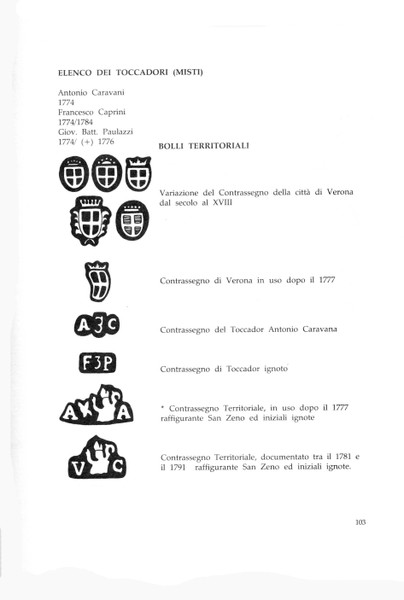
Andrea came back to me with; now let's look at Verona, and no longer at Venice. It must be said that the hallmarks and silversmith's marks of Verona are poorly documented. In the front part of the fork, a mark containing the image of San Zeno can be clearly recognized, which is a territorial mark in use in Verona towards the end of the 18th century.
The marks on tip of fork

The mark on the fork is not exactly the same as those shown on the books, but it is certainly a Veronese territorial mark. The other, identical to mark#1 is presumably another "official" mark. The key on the back is most likely the workshop mark.
The post 1812 hallmarks were probably struck on request of the owner to certify that it was silver, perhaps for an inheritance or a sale. It's something I've seen before.
On the spoon we find the mark#1, which confirms, together with the key and the initials P^M, that the object is Veronese.
Mark#2, however, does not appear to be one of those with San Zeno?
I repeat, the Veronese hallmarks are poorly documented.
However Andrea found another image with Veronese marks on Beweb, marks seen on reliquary, which solved the puzzle
https://beweb.chiesacattolica.it/
We believe, that the unclear mark # 2 on the spoon is the town mark of Verona, San Zeno;
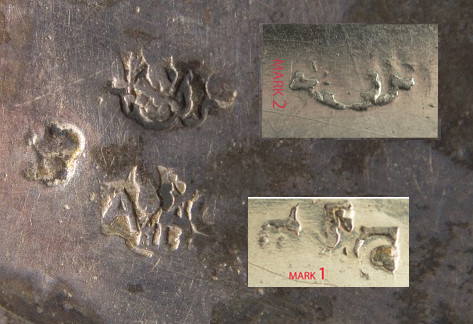
The icing on the cake, Adrea found who the key belonged to:
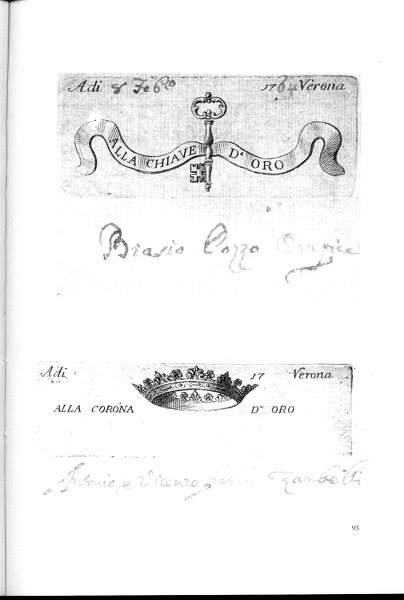
Alla chiave d'oro = the key of gold for; Biasio (venetian dialect for Biagio) Pozzo Orefice (goldsmith)
 (principal = master)
(principal = master) Source; I PUNZONI DELL'ARGENTERIA VENETA TOMO II LO STATO VENETO di PIERO PAZZI 1992 page 93
Peter.
Source/ gratitude; https://divaantwerp.be/en/?gclid=Cj0KCQ ... gZEALw_wcB, Dr. Wim Nys , images fork by; Ludo Heymans, images spoon by; Hans Breet.
I PUNZONI DELL'ARGENTERIA VENETA TOMO II LO STATO VENETO di PIERO PAZZI 1992 page 93,
Beweb; https://beweb.chiesacattolica.it/, Giorgio Busetto website; https://www.silvercollection.it/, the 925-1000 forum members, Theo and Andrea.